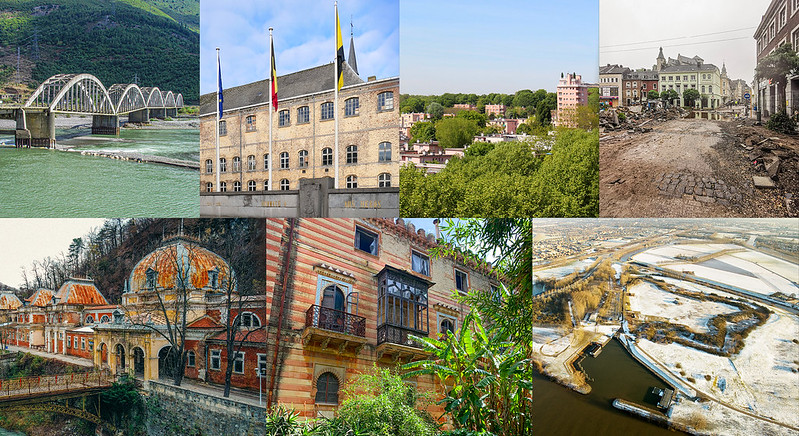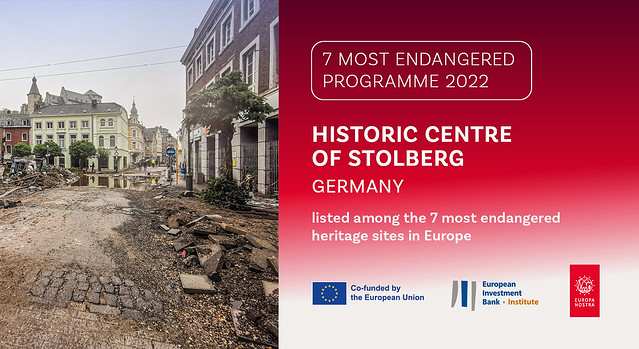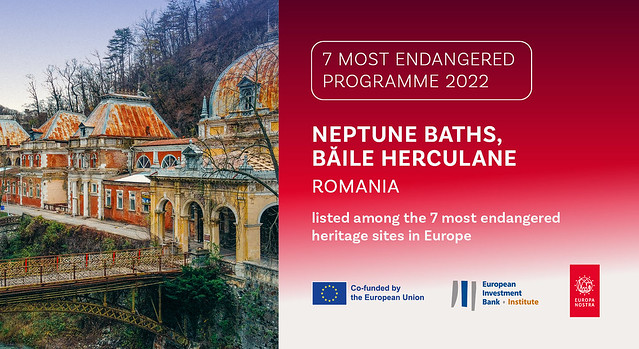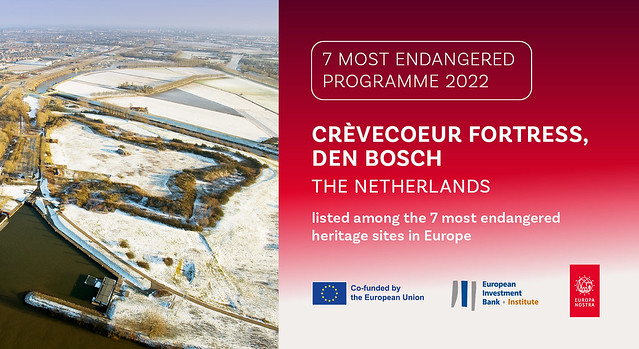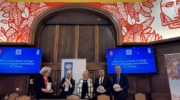Europa Nostra and EIB Institute announce Europe’s 7 Most Endangered heritage sites 2022
Press releases All sites – English │ Zogu Bridge – Albanian │ Récollets Convent – Dutch & French │ La Butte Rouge – French │ Stolberg – German │ Neptune Baths – Romanian │ Orléans-Borbón Palace – Spanish │Crèvecoeur Fortress – Dutch
Photos & e-banners │ Videos
The list of the 7 Most Endangered monuments and heritage sites in Europe for 2022 has just been jointly announced by Europa Nostra – the European Voice of Civil Society Committed to Cultural and Natural Heritage – and the European Investment Bank Institute.
The 7 Most Endangered monuments and heritage sites in Europe for 2022 are:
Zogu Bridge, ALBANIA
Récollets Convent, Nivelles, BELGIUM
Garden City La Butte Rouge, near Paris, FRANCE
Historic Centre of Stolberg, GERMANY
Neptune Baths, Băile Herculane, ROMANIA
Orléans-Borbón Palace, near Cádiz, SPAIN
Crèvecoeur Fortress, Den Bosch, THE NETHERLANDS
The announcement of the 7 Most Endangered sites 2022 was made at an online event co-hosted by high level representatives of Europa Nostra and the European Investment Bank Institute, with the participation of Mariya Gabriel, European Commissioner for Innovation, Research, Culture, Education and Youth. Nominators and representatives of the 7 selected sites contributed to the online event, which attracted participants from across Europe and beyond.
In his address during the online event, the Executive President of Europa Nostra, Prof. Dr. Hermann Parzinger, stated: “The list of the 7 Most Endangered 2022 covers a variety of heritage sites – from an exemplary 20th-century garden city to the historic centre of a medieval town, severely damaged by floods, and to an abandoned yet iconic building that is part of one of the oldest spa resorts on our continent. These sites are threatened by neglect, planned demolition, unsuitable development, the devastating impact of natural disasters or lack of funding. By publishing this list, we wish to send a strong message of solidarity and support to the local communities and heritage activists who are mobilised to save these endangered sites. Europe’s cultural heritage must be preserved not only as a testimony of our shared past, memory and identity, but also as a catalyst for sustainable development, social cohesion and much-needed peaceful co-existence.”
In his address Henry von Blumenthal, Deputy Dean of the European Investment Bank Institute, added: “Cultural heritage is about far more than ‘stones and bones’ from the past. It is a key resource for European identity, attractiveness and economic growth. Its positive and cohesive power connects Europe’s citizens and communities. For all these reasons, the EIB Institute is once again proud to be supporting the 7 Most Endangered Programme with Europa Nostra, Europe’s leading cultural heritage organisation”.
On this occasion, the Secretary General of Europa Nostra, Sneška Quaedvlieg-Mihailović, drew special attention to the statement Europa Nostra stands in solidarity with Ukraine, issued on 25 February, and to the crowdfunding campaign to support the defenders of Ukraine’s endangered heritage jointly launched by Europa Nostra and Global Heritage Fund on 18 March. “As stated by our Board at its meeting held on 10 March, the rich and diverse heritage in Ukraine is THE most endangered heritage in the whole of Europe. We therefore need to provide support to our heritage colleagues in Ukraine. Every organisation or individual from Europe and beyond, who is dedicated to culture, heritage and history, can contribute to our crowdfunding initiative. Let’s stand together in solidarity with heritage defenders in Ukraine!” said Sneška Quaedvlieg-Mihailović. All donations will provide emergency support to these brave guardians of our shared history and humanity. All contributions, however big or small, are welcome and important, and can easily be made via the Europa Nostra website (in Euros) or via the Global Heritage Fund website (in USD, GBP or crypto).
Mariya Gabriel, European Commissioner for Innovation, Research, Culture, Education and Youth, stated: “The preservation of our heritage is an essential part of protecting our sense of identity, a sense of who we are. In times of crises, culture gives us something to hold on. Cultural heritage promotes togetherness, it connects our society. To be better prepared for the future, we need to preserve our past, we need to study the roots of our civilisations, become conscious of history, and as generations come and go, everyone is inspired by what we have done in the past.”
The 7 Most Endangered sites for 2022 were selected by the Board of Europa Nostra from the 12 sites shortlisted by a panel of international experts. The selection was made on the basis of the outstanding heritage significance and cultural value of each of the sites as well as on the basis of the serious danger that they are facing. The level of engagement of local communities and the commitment of public and private stakeholders to saving these sites were considered crucial added values. Another selection criterion was the potential of these sites to act as a catalyst for sustainable socio-economic development as well as a tool for promoting peace and dialogue within their localities and wider regions.
Teams of experts representing Europa Nostra and the European Investment Bank Institute, together with the organisations that nominated the sites and other partners, will assess each case by collecting information and by meeting with key stakeholders. These multidisciplinary teams will provide expert advice, identify possible sources of funding and help mobilise wide support to save these heritage landmarks. At the end of the assessment process, they will formulate and communicate a set of recommendations for future action.
The 7 Most Endangered Programme is run by Europa Nostra in partnership with the European Investment Bank Institute. It also has the support of the Creative Europe programme of the European Union through our Network project European Cultural Heritage Agora: “Empowering Europe’s Civil Society Movement for Heritage” (2022-2024). Launched in 2013, the 7 Most Endangered Programme forms part of a civil society campaign to save Europe’s endangered heritage. It raises awareness, prepares independent assessments and proposes recommendations for action. It also provides a grant of €10,000 per listed site to assist in implementing an agreed activity that will contribute to saving the threatened site. In most cases, the listing of an endangered site serves as a catalyst and incentive for the mobilisation of necessary public or private support, including funding.
The 7 Most Endangered heritage sites in Europe for 2022
(listed in alphabetical order of the country where they are located)
Zogu Bridge, ALBANIA
The Zogu Bridge is a masterpiece of civil engineering from the early 20th century in the Balkans. Built in 1927 over the Mat River in Northern Albania, the bridge is renowned for its architectural structure, its length and the style of its steel arches.
Despite its industrial heritage importance and the fact that the bridge was declared a Cultural Monument of first category by the National Institute for Cultural Heritage in Albania, the Zogu Bridge has been poorly maintained. The structure is in imminent danger of collapse due to damage caused to one of its columns.
Since the construction of two new bridges over the Mat river in 1987 and 2000, the Zogu Bridge has been disused, but it is frequently visited by tourists given its original design and historic value.
Nominated by an individual member of Europa Nostra from Albania.
Récollets Convent, Nivelles, BELGIUM
The Récollets Convent is the only completely preserved example of Franciscan architecture in Belgium and is one of the few remaining of its type in Europe. Built in 1524, it includes a late Gothic church – classified as a national monument in 1936 and last restored in the 1970s – which is still used for worship. The remaining buildings of the complex, organised around a cloister and three wings, are in urgent need of maintenance.
The Récollets Convent is threatened by a large-scale real estate project, developed in 2019 by the owner and supported by the local authorities. The implementation of such a project would reduce the historical buildings and the surrounding green space with ancient trees to a private area with new apartments.
Nominated by Europa Nostra Belgium, which submitted the official request for the classification of the entire complex as a historical monument to the Wallonia Heritage Agency and has supported activities to save the site.
Garden City La Butte Rouge, near Paris, FRANCE
The Garden City La Butte Rouge (1931-1965) stands out as a model of garden cities in Europe. It is a living testimony of 20th-century social housing, and its architecture is strongly influenced by the Modern and Art Déco movements and the Bauhaus school. La Butte Rouge has remained intact to the present day. It consists of 4,000 apartments and a green area spreading over 70 hectares, and is home to thousands of people.
For the last three years, the City of Châtenay-Malabry has made clear its intention to demolish La Butte Rouge, emphasising that it does not meet new building requirements. Around 85% of the buildings of the complex are at risk of being lost. The destruction of 14 historical buildings is already planned and the inhabitants have been forced to leave their houses. Local protests have been organised, including petitions to save the site.
Nominated by an individual member of Europa Nostra, with the endorsement of Vieilles Maisons Françaises, Europa Nostra’s founding member organisation from France.
Historic Centre of Stolberg, GERMANY
Stolberg is a medieval town in North Rhine-Westphalia in the western part of Germany. In the wake of the flourishing copper-based industry, other industries soon followed, making Stolberg a very important place for Europe’s industrial heritage. The appearance of the historic centre is predominantly determined by the local limestone.
In mid-July 2021, the historic centre of Stolberg was unexpectedly turned into a flood zone. Some 266 listed buildings were severely damaged by the forceful waters of the Vicht river, following extreme weather conditions.
In the plans for the reconstruction of Stolberg’s centre, the spotlight would need to be put on the city’s resilience and on how to better resist further climate change induced threats in a responsive and effective way in the future.
Nominated by an individual member of Europa Nostra with the endorsement of a large number of German and European organisations, bodies and individuals concerned for the future of the town.
Neptune Baths, Băile Herculane, ROMANIA
The Neptune Baths form part of the thermal town of Băile Herculane, one of the oldest spa resorts in Europe, dating back to 153 AD. The current structure of the Neptune Baths was constructed between 1883 and 1886. Designed in an eclectic style, Neptune Baths have a total surface area of almost 4000 sqm. Its medical treatment centre boasted renowned doctors as well as visits from notable guests, such as the royal Habsburg family.
After the fall of communism in Romania in 1989, the historic resort of Băile Herculane was abandoned and fell into decay with the damage accelerating from 2004 onwards. Despite being declared as a Class A monument in 1980, the building has suffered continuous degradation. Due to a lack of funding and legal issues, two structural walls and a roof collapsed in 2019. A series of temporary interventions were executed under the coordination of a team of volunteers with the support of civil society, but the building continues to degrade at a fast pace.
Nominated by Locus Association, an NGO run by volunteer architecture professionals and young graduates.
Orléans-Borbón Palace, near Cádiz, SPAIN
The Orléans-Borbón Palace was built in the mid-19th century in Neo-Moorish style, combined with Neo-Arab architectural elements and a variety of stylistic influences from all over the world. At the rear of the palace, there are extensive gardens with characteristics from Romantic gardens that are enriched by Islamic influences.
The history of this fascinating Andalusian building was linked for many years with the Montpensier family. The palace was inhabited by the family until 1955. During the 1970s, it was sold twice. In 1979, the Municipality of Sanlucar de Barramedabegan began the process of acquiring the property, with the aim of avoiding its destruction and opening it to the public. In 1982, the Orléans-Borbón Palace was declared an Asset of Cultural Interest. Since the renovations in the 1990s, the owner could not ensure proper maintenance which resulted in the building being in urgent need of restoration. The outer walls of the building are at imminent risk of collapse.
Nominated by Hispania Nostra, Europa Nostra’s country representation in Spain.
Crèvecoeur Fortress, Den Bosch, THE NETHERLANDS
Strategically located at the point where the river Dieze flows into the Maas river, the Crèvecoeur Fortress was built in 1587 and has played an important role in Dutch military and diplomatic history for over 300 years.
The Crèvecoeur Fortress was decommissioned in 1890 and fell into decline. After its rehabilitation, during World War II, the fortress was used by the German army as a bridgehead over the Maas river until 1944. After the war, the Dutch army used the fortress as a training ground.
The fortress is owned by the Dutch Ministry of Defence. A listed National Monument since 1973, the now severely neglected fortress and terrain need urgent restoration before the structures crumble beyond repair.
Nominated by Bond Heemschut – The Dutch Association for Heritage Protection, Europa Nostra’s founding member organisation from the Netherlands.
FIND OUT MORE
About each listed site
www.7mostendangered.eu
http://institute.eib.org
Europa Nostra
Sara Zanini
sz@europanostra.org
+32 486 58 95 19
Europa Nostra
Joana Pinheiro
jp@europanostra.org
+31 6 34 36 59 85
European Investment Bank Institute
Bruno Rossignol
bruno.rossignol@eib.org
T. +352 43 797 07 67; M. +352 621345 862
